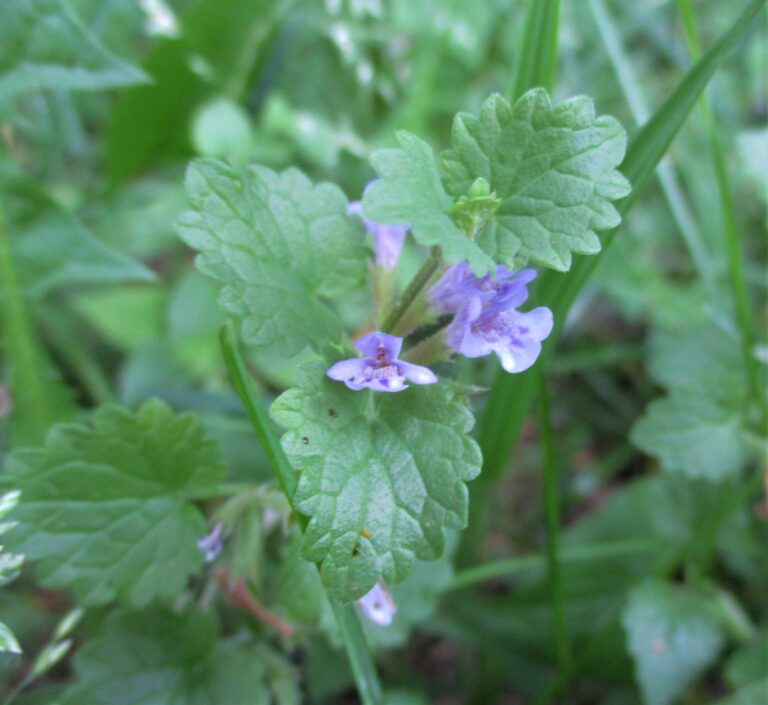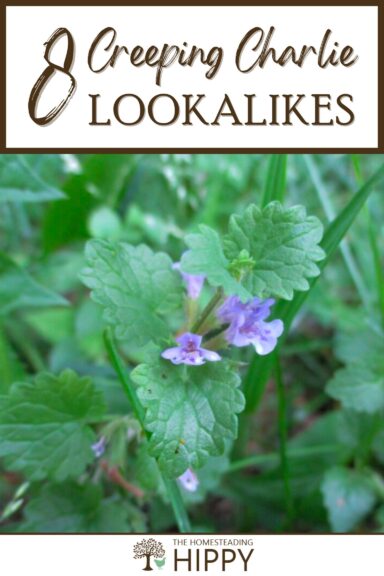You know what they say, one person’s weed is another person’s treasure. Okay, that isn’t how the saying goes but the sentiment is certainly true!

What one person curses as an aggravating and invasive plant another person might give a prayer of thanks for finding.
I don’t know of any such plant that fits that description more than Creeping Charlie, AKA ground ivy or Glechoma hederacea.
Creeping Charlie is pervasive, persistent, and grows explosively in ideal conditions, three things that make it a big pest in the garden if you don’t want it there.
But it’s also highly nutritious, and has a place in many recipes making it a great wild edible. Of course, it also has many look-alikes, some of which are helpful and some of which are not.
I’ll tell you about some of the most common Creeping Charlie lookalikes below…
Table of Contents
1. Creeping Jenny (Lysimachia nummularia)
If you know Creeping Charlie, you’re probably already familiar with Creeping Jenny, also known as Lysimachia nummularia.
Another perennial often mistaken for Creeping Charlie due to its similar growth habit and appearance.
Native to Europe and temperate Asia, it’s a familiar sight in many gardens and landscapes, and has established itself elsewhere due to importation and contamination of soil and mulch.
Creeping Jenny forms spreading mats of long, trailing stems, adorned with rounded, smooth, and usually (but not always) shiny leaves.
And here’s the giveaway between the two: In the summer, Creeping Jenny produces many cup-shaped, bright yellow flowers- a feature that has endeared it to some gardeners.
Although the blooms don’t last long, they are beautiful while they do! Creeping Jenny shows high adaptability, too, thriving in both full sun and partial shade and tolerating a variety of soil conditions.
And no need to worry if you have pets or small children: Creeping Jenny is generally safe and non-toxic.
Nonetheless, I advise you to watch young children and pets around any plants as a precautionary measure.
2. Purple Dead Nettle (Lamium purpureum)
Purple Dead Nettle, or Lamium purpureum, is a common sight in many parts of the world and is often confused with Creeping Charlie due to its similar growth habit and appearance – though its foliage is distinct to the trained eye.
Purple Dead Nettle is a fast-growing annual native to Europe and Asia, and gets its name from the striking purple color of its leaves and flowers alike.
Like many nettles, this plant has a square stem and heart-shaped leaves, which can easily set it apart from Creeping Charlie.
Purple Dead Nettle plant is an excellent source of pollen and nectar for bees in early spring, making it a valuable addition to any garden if you want to attract helpful pollinators.
It was also used traditionally by Native Americans to help with a variety of ailments. All good stuff!
But, despite its practical benefits, Purple Dead Nettle can be a very aggressive grower and may become invasive if not diligently tended.
Also, while it’s generally considered safe, some people do report skin irritation after handling or contacting the plant, so it’s advisable to wear gloves.
3. Bird’s-Eye (Veronica persica)
The Bird’s-Eye, also known as Veronica persica or Persian Speedwell, originated in Eurasia and is now naturalized throughout North America, finding a permanent home in gardens, lawns, and in the wild anywhere disturbed soils are found.
It’s a common lookalike for Creeping Charlie due to its sprawling growth habit and similar leaf shape, though other physical characteristics are distinctive.
Its small stature, typically between 4-12 inches long, belies its pervasive nature: Bird’s-Eye forms dense mats of vegetation, with long, seeking stems branching occasionally and sprawling across the ground.
It instantly stands out thanks to its blooms, with bright blue to purple flowers. Interestingly, this plant tends to be most active during the winter or early spring, setting it apart from many other plants.
Bird’s-Eye is non-toxic and is indeed a popular inclusion in beds, window boxes and gardens, but its aggressive growing nature and tendency to not “take off” in the winter can make it a nuisance.
4. Garlic Mustard (Alliara petiolata)
Next up is Garlic Mustard, or Alliara petiolata. And no, it isn’t a condiment like you’re thinking!
At first glance, you might confuse this plant with Creeping Charlie due to its leaf shape and the way it spreads, but take a closer look, and you’ll easily see differences that set it apart.
Garlic Mustard is a cool-season biennial herb native to Europe, commonly found in forests, woodlands, and shaded roadsides.
It has since spread across much of North America and is essentially naturalized.
Garlic mustard has toothed leaves with that spearhead or heart shape that look very different from the shovel-shaped, bluntly toothed leaves of Creeping Charlie.
In the spring, Garlic Mustard produces clusters of small, white flowers.
The unique feature of Garlic Mustard, as the name suggests, is its strong, mustardy, garlic-like smell when its leaves are crushed or broken, lending the plant its name.
And while it’s not toxic and is even edible, Garlic Mustard is still an invasive species in the US that can outcompete native plants for resources.
So, while you might be tempted to let this plant grow in your garden for its unique smell and edible nature, be aware of its invasive tendencies and try to control it…
5. Henbit (Lamium amplexicaule)
If you spot a plant in or near your garden, or anywhere else, that looks suspiciously like Creeping Charlie, take a closer look: It might just be Henbit, also known as Lamium amplexicaule.
This plant, another member of the mint family, is native to Europe, Asia, and northern Africa but has since made its way to North America like so many other imports, wanted or not.
You’ll find Henbit growing in cool seasons, standing out with its sparsely hairy, greenish or purplish stems that are square-shaped, much like Creeping Charlie.
However, there are a few key differences between the two: Henbit’s leaves, unlike those of Creeping Charlie, are not associated with flowers.
Instead, they grow in circles around the stem, giving the plant a unique arrangement in comparison.
In the springtime, Henbit produces beautiful, small purple flowers that look very much like Creeping Charlie, leading to the aforementioned confusion.
Despite being an annoying weed in many places, Henbit is actually edible. The plant is not toxic, and can be a nutritious addition to your meals thanks to its celery-like texture and peppery flavor.
And if the name wasn’t clue enough, know that chickens love the stuff, which is how it got its common name.
6. Common Mallow (Malva neglecta)
Another common Creeping Charlie lookalike, the Common Mallow (Malva neglecta) at first glance is another imposter thanks to its leaves and growth habits, but close inspection will tell the tale.
Its rounded, lobed leaves and pink to white flowers make it easy to identify once you know what to look for.
Common Mallow stands out further with its unique seed pods, which resemble miniature wheels of cheeses. This feature has earned it the nickname “cheeseweed.”
Common Mallow is a perennial that’s hails from Europe but has since spread throughout North America and even parts of Central America.
Thriving in disturbed soils, you’ll often find it as a pest in gardens and along roads and trails. Despite being a weed, Common Mallow is actually edible and has been used eaten as food for ages.
For a time, it was even an important seasonal crop in its native range, though it has been relegated to a survival food or oddity today.
However, while it’s not toxic, it can be a highly persistent nuisance.
Its prolific seed production and ability to regrow from tiny fragments make it a tough weed for you to eradicate and it’s turning into a legitimate problem in many places.
So, if you spot Common Mallow in your garden, it’s best to manage its growth before it totally takes over, and consider reporting it to your local nature bureau.
7. American Water Pennywort (Hydrocotyle americana)
If you ever go near wetlands and notice a small, creeping plant that reminds you of Creeping Charlie, it might be the American Water Pennywort, also known as Hydrocotyle americana.
A native plant this time, it is common in the Northeastern United States and is routinely found growing in moist areas like bogs, wet woods, lake margins, swamps and regularly flooded areas.
American Water Pennywort has slender stems that creep over moist or wet ground, rooting at the nodes, like Creeping Charlie.
But its leaves are round and it produces tiny clusters of greenish-white flowers rising from the leaf axils.
The growth habit and appearance of this plant might lead to a case of mistaken identity with Creeping Charlie until you look more closely…
American Water Pennywort is also highly adaptable to both sun and shade environments.
Happily, the American Water Pennywort is not known to be toxic or dangerous but, like any other plant, it should not be consumed or handled without a positive ID and proper knowledge.
8. Ponysfoot (Dichondra carolinensis)
Another garden invader commonly mistaken for Creeping Charlie, you might instead be dealing with Ponysfoot, scientifically known as Dichondra carolinensis.
A perennial herb native to the Southeastern United States, it’s often found in open woods and, increasingly and unwantedly, in lawns and gardens.
But surprisingly enough, some folks like it as a supplement or substitute to grass for the purpose: it makes a practical ground cover, creating a dense, mat-like cover that’s resistant to moderate foot traffic.
That’s because Ponysfoot has a prostrate growth habit, with stems that run all along the ground, sprouting leaves and radiating onward at nodes.
Leaves are kidney-shaped, a feature that easily sets it apart from Creeping Charlie if you know your plants.
In the spring, Ponysfoot produces small, inconspicuous greenish-yellow flowers that won’t dominate the aesthetics of your lawn, another feature that has made it some fans.
Better yet, Ponysfoot is generally safe and isn’t known to be toxic, although all interactions with people and pets are not totally understood.

Tim is a farm boy with vast experience on homesteads, and with survival and prepping. He lives a self-reliant lifestyle along with his aging mother in a quiet and very conservative little town in Ohio. He teaches folks about security, prepping and self-sufficiency not just through his witty writing, but also in person.
Find out more about Tim and the rest of the crew here.
